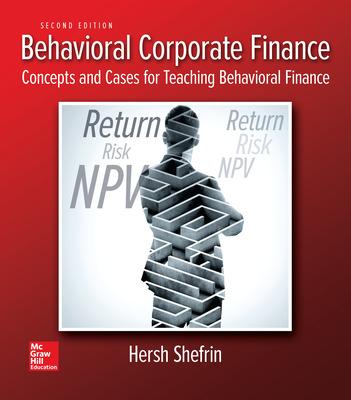Discuss the psychological aspects associated with how Groupons board and executives analyzed whether or not they should
Question:
- Discuss the psychological aspects associated with how Groupon’s board and executives analyzed whether or not they should accept Google’s offer.
- Consider the notion of “transaction utility.” How does this concept apply to Groupon’s business strategy?
- Compare the IPOs of Groupon, Facebook, and Twitter in respect to hot issue market, initial underpricing, and long term underperformance.
- Given the details in the minicase, to what extent did Groupon, Facebook, and Twitter engage in either ca- tering behavior or market timing?
- Discuss the chronology of Twitter through the lens of the Baker-Wurgler sentiment framework.
Groupon grew its business based on a simple idea: to provide an Internet platform that would allow local mer- chants to offer deals to retail customers in the form of coupons, subject to the number of customers accepting the offer exceeding a minimum threshold. Groupon’s rev- enue stemmed from taking a share of the revenue from these sales. Groupon’s coupon-based strategy exploited a psychological issue that behavioral economists call “transaction utility,” whereby consumers derive benefit from making a good deal that adds to the benefit called “acquisition utility,” stemming from the use of the good or service itself.
Groupon was founded in 2008 and grew rapidly over the next three years, leading many investors to wonder whether it would be as successful as Amazon had in cre- ating an online retail superstore. Executives at Yahoo! and Google thought this possibility to be sufficiently likely that in 2010 they explored acquiring Groupon, with Google offering to pay $5.7 billion, four times more than Yahoo! had offered.
Groupon’s board and executives were ambivalent on whether to accept Google’s offer. The firm’s sales had been approximately $25 million per month, but had quickly doubled. The firm’s data scientist suggested that by optimizing its processes, the firm could soon be ten times larger. In the end, Groupon declined Google’s offer, and by the second half of 2011, its revenues (not adjusting for return sales) exceeded $400 million per month.
Groupon’s IPO took place on November 4, 2011, at an offer price of $20 per share, in which the company sold 5 percent of its shares. During its first trading day, the company’s stock price briefly rose above $30, and closed at $26.11, with an implied valuation of approximately $16.5 billion. Groupon’s IPO was the second largest of the year for a technology firm, after professional networking firm LinkedIn had gone public in May: LinkedIn’s shares more than doubled on its first trading day.
At the time of its IPO, the New York Times described Groupon as a firm with momentum but no profits whose offering not only stunned Wall Street but also echoed the dot.com bubble. In this regard, The Times interviewed money manager Josef Schuster at IPOX Schuster, who indi- cated that investors’ willingness to take a risk with Groupon would have a positive spillover effect on other technology offerings.31 At the same time, Schuster noted that thereafter the risk was to the downside, that he did not buy shares on November 3, that in the short term it would be expensive to short the stock, and that in the short term trading the stock would be popular among short-term traders.
In February 2012, Groupon announced a loss of $37 million on revenue of $506.5 million for the fourth quarter. In reaction, its stock price declined below $20.
At the time of its IPO, Groupon faced criticism about unorthodox accounting practices. In March 2012, it ...
Step by Step Answer:

Behavioral Corporate Finance Concepts And Cases For Teaching Behavioral Finance
ISBN: 9781259277207
2nd Edition
Authors: Hersh Shefrin





